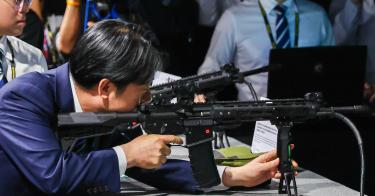In the face of increased drills, military action, and threatening rhetoric from the People’s Republic of China, Taiwan recently announced that it’s raising its core defense spending to 3 percent and plans to reach 3.32 percent by next year.
Taiwan is also the first non-NATO country to align itself with NATO’s new 5 percent pledge, an agreement by the allies to spend 3.5 percent of gross domestic product (GDP) on core defense spending and at least 1.5 percent of GDP on associated infrastructure investment by 2030. These commitments demonstrate Taipei’s increased seriousness regarding defense.
Taiwan should prioritize acquiring the necessary weapons systems to deter and, if necessary, defeat an invasion by the People’s Liberation Army. That means enhancing its capabilities in long-range strike weapons, mobile anti-ship missiles, air and missile defense, anti-armor weapons, and their enablers.
Other considerations, like countering gray-zone tactics, must take second place to the primary goal of deterring or defeating an armed invasion.
>>> How America Can Beat China and Herald a New Golden Age
Taiwan’s new spending recognizes the need for these systems. Already, the country has purchased large numbers of High Mobility Artillery Rocket System (HIMARS) launchers, a capability critical to deterring a Chinese amphibious assault against the island.
In addition to purchasing defense systems from partnering countries, Taiwan can also develop its robust manufacturing base to expand its missile defense construction, drone production, and energy stockpiles.
Taiwan has already begun this process—aided by its direct access to required materials, including microchips, and by U.S. investments, including those enacted in President Trump’s One Big Beautiful Bill Act. In September, for example, Taiwan officially rolled out the Chiang Kung, a new domestically produced high-altitude anti-ballistic missile system.
Aside from producing weapons systems, Taiwan must also prioritize information gathering and communication technology to maintain a link with U.S. forces in the event of aggression.
Currently, Taiwan relies on undersea cables for global connectivity and essential networks. This system is highly vulnerable to damage and has previously shown evidence of possible sabotage, making it essential that Taipei diversifies its communications infrastructure.
The United States must also contribute to the effort to improve the communications infrastructure with Taipei. Already, Taiwan, the United States, Japan, and South Korea are working toward this via the E2A, a trans-Pacific fiber-optic network that will increase connectivity between all four participants.
While Taiwan has rapidly increased its own domestic production capabilities, help from the United States and others would significantly accelerate this process. Already, the nation has signed a memorandum of understanding with Ukraine and Poland to advance drone technology—although it’s unclear how quickly the process is moving or what tangible results will be delivered from the Ukrainian and Polish governments.
>>> America Doesn’t Have To Depend on China To Build Chips and Batteries
Yet, despite Taiwan’s efforts to build new ties, most countries have been reluctant to increase security cooperation with Taiwan, fearing Chinese reprisals—even though Western European countries, for example, sold major weapons systems to Taiwan during the Cold War.
The United States’ Indo-Pacific allies should look for ways to increase their security cooperation with Taiwan across the board. Recipients of American military aid and technology—like Ukraine—should be willing to engage with Taiwan at all levels and share drone technology and best practices from the ongoing war.
The United States remains Taiwan’s key supplier of military equipment, having supplemented Taiwanese domestic production for decades. Unfortunately, though, there’s a substantial backlog—totaling around $20 billion—in military equipment that Taiwan has already purchased but which has not yet been delivered. The United States needs to move quickly to clear this backlog, prioritizing deliveries to Taiwan as a demonstration of its new prioritization of Taiwan and the Indo-Pacific, and moving it to the front of the line for the delivery of critical systems, such as HIMARS and Harpoon missiles.
The need for this prioritization is clear.
In a recent military parade that brought together the leaders of China, Iran, North Korea, and Russia, Chinese president Xi Jinping asserted that the world was facing a turning point between peace and war. Taiwan’s latest defense spending increase, along with the planned increases for the next couple of years, indicates that Taipei is beginning to recognize the severity of the situation and is taking steps to arm itself.
Americans should applaud this move and encourage Taiwan to continue to increase defense spending, even as the United States invests in its own military and shifts forces to the Indo-Pacific as part of a broader effort to deter Chinese aggression.
This piece originally appeared in The National Interest




